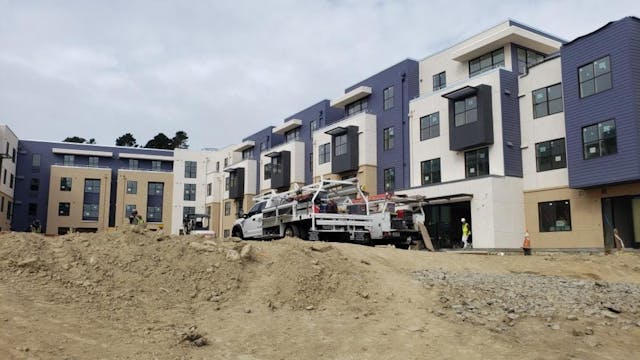Shirley Cruz used to pass an old parking lot on her way to and from work.
Adjacent to a former high school, the lot was wasted space back then, she says. Uber and Lyft drivers would congregate there, waiting to get assigned to their next rides, Cruz recalls. Otherwise, it sat empty.
In Daly City, California, just south of San Francisco city limits, that’s prime real estate. The owners of the abandoned parking lot and the land beneath it — the local school district — realized as much, and they hatched a plan.
Now, Cruz doesn’t drive past it. She lives on it — in a district-owned, newly constructed apartment complex occupied exclusively by the teachers and staff of Jefferson Union High School District.
It’s an approach that is gaining momentum among public school districts nationwide. Many are dealing with vacancies and educator attrition rates at levels that are not only inconvenient but actually harmful to the staff, students and families in their communities. In a number of places, including the San Francisco Bay Area, exorbitant housing costs are responsible for high teacher turnover rates. So districts, often sitting on vast swaths of underused and undeveloped land, are getting creative.
Jefferson Union High School District is among the first school districts in the country to see its affordable housing project through to completion — staff began moving in over a year ago, and today, the 122-unit complex is fully occupied — but scores of others are not far behind.
In California alone, at least 46 school districts were pursuing workforce housing projects on 83 sites statewide as of March 2022, according to research from the Center for Cities + Schools at the University of California, Berkeley. Projects in North Carolina, Texas, Missouri, Colorado, Illinois and elsewhere are also underway.
As more districts seek to address the housing crisis in their communities — an issue EdSurge explored in depth in a recent story — we wanted to look at the school district in Daly City that, at least for now, has solved its housing woes.
Drawing Up Plans
Before its employee housing program launched in 2022, JUHSD was losing between 20 and 25 percent of its staff every year.
“We kept hearing, ‘It’s not because we don’t want to work here. It’s because we can’t live here,’” says Austin Worden, director of communication and staff housing for the district.
Housing in the Bay Area is notoriously pricey, notes Worden, “but in recent years, the spike is just unreal — just through the roof,” he says. The average rent for apartments in Daly City in 2023 ranges between $2,344 and $3,692 a month, according to Rent.com. “What we’re giving in salary raises doesn’t even compete,” Worden adds.
JUHSD is the lowest-funded high school district in San Mateo County, California, which is one of the most expensive places to live in the United States. Teacher salaries in Jefferson Union range from around $62,000 to $107,000 a year, compared to nearby San Mateo Union High School District, where teachers can earn between $79,000 and $148,000 a year.
School districts sometimes raise money by selling bonds, but Jefferson Union leaders knew they wouldn’t be able to use bond funds to increase staff salaries. What they could do with a bond was build. The district had plenty of land and property ripe for development. If housing was the main driver of high turnover rates and district leaders couldn’t adjust salaries in line with housing costs, they thought, why not just build staff housing?
A $33 million voter-approved bond passed in June 2018. The remainder of the $75.5 million housing project was financed through a Certificate of Participation (COP).
The goal, says Worden, was for about a quarter of the district’s 530 staff members to live in the eventual apartment complex, and to price rent for the units about 50 percent below market rates.
In practice, the rental units are around 60 percent of market rates — between $1,350 and $1,580 a month for a one-bedroom apartment in the district-owned building, compared to about $2,400 a month elsewhere, Worden says — so a considerable discount.
By May 2022, staff were moving into the building, which has a mix of one-, two- and three-bedroom units and includes modern appliances and amenities such as a fitness center, common rooms with workspaces, playgrounds, community centers and parking.




